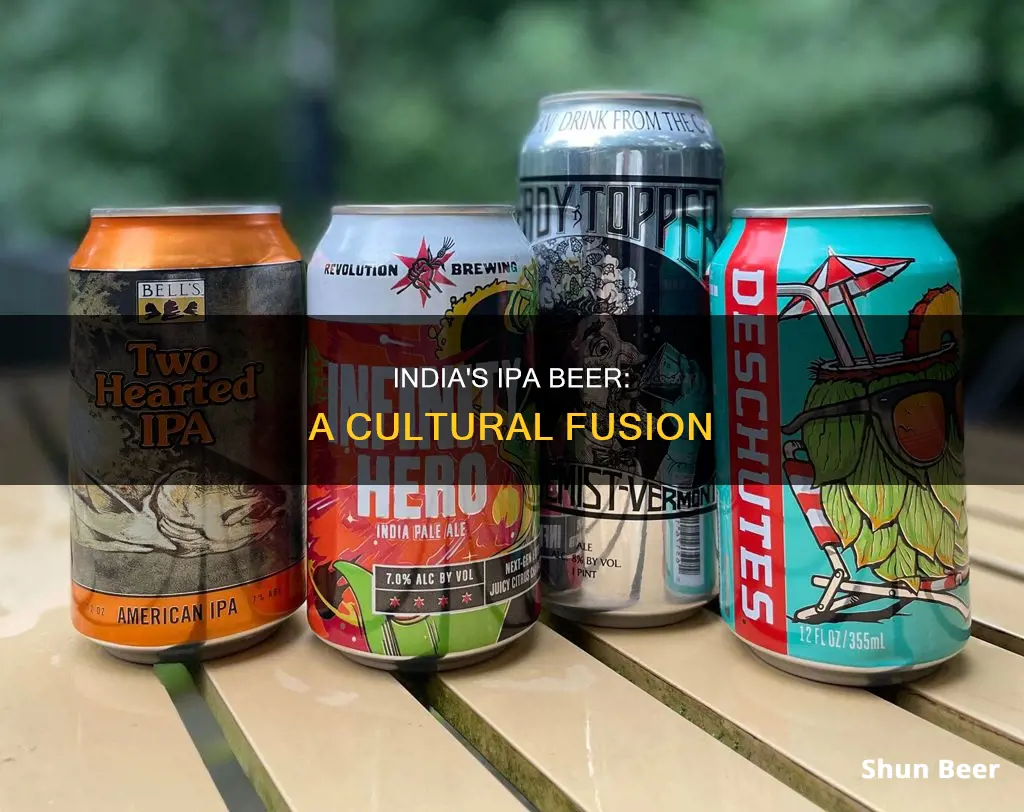
India Pale Ale (IPA) was created for British colonists in India. The British received beer shipments directly from England, but the beer often spoiled during the long voyage. Brewers began experimenting with different ingredients and eventually added more hops and alcohol, which acted as preservatives. This new beer survived the journey and was surprisingly aromatic and bitter. The soldiers loved it, and thus, the India Pale Ale was born.
What You'll Learn

IPA was created for British colonists in India
India Pale Ale (IPA) was not created in India, but in England, and was brewed for British colonists in India. During the height of the British Empire, Britain had emigrants, sailors, and troops all over the world, with India being one of its most important outposts. All demanded beer, but India's hot weather made brewing there difficult. Without refrigeration, the intense heat sped up fermentation, changing flavours in unpredictable and often unpleasant ways. This made brewing in India largely unsuccessful.
Shipping beer to India from England was also challenging. The long voyage in hot conditions caused the beer to spoil, become stale, or get infected before it arrived. George Hodgson, a London brewer in the late 1700s, used his connections to the East India Company to dominate the export market to the colony. Hodgson exported a strong pale ale, brewed with extra hops and higher alcohol levels, both of which act as preservatives. The beer was also similar to barley wine. The long voyage transformed the beer, and by the time it reached India, it was aromatic, bitter, and stronger in both flavour and alcohol content.
The soldiers loved it, and thus, the India Pale Ale was born.
The Birth of Guinness: A Historical Perspective
You may want to see also

The beer was brewed with extra hops and alcohol to survive the voyage
The India Pale Ale (IPA) was created to ensure the British, who were colonizing India, could continue drinking beer. The hot weather in India made brewing beer difficult, and the intense heat would cause fermentation to speed up, resulting in inconsistent and unpleasant flavours.
Shipping beer to India from England was also challenging, as the beer would often spoil, become stale, or get infected during the long voyage. Brewers in England, therefore, had to find a way to ensure the beer could survive the journey.
George Hodgson, a London brewer in the late 1700s, decided to use hops and alcohol to create a beer that could survive the voyage to India. Hops and alcohol have preservative effects, with hops being the key bittering agent and alcohol being produced as a byproduct of fermentation.
Hodgson brewed a particularly alcoholic beer (similar to a barley wine) and added extra hops to create a refreshing aroma and taste. The long voyage to India transformed the beer, and the soldiers loved the resulting aromatic and bitter flavour. Thus, the India Pale Ale was born.
The creation of the IPA was a result of human ingenuity, as humans have a long history of devising ways to preserve fermented beverages. The use of hops and alcohol in the brewing process allowed the beer to survive the voyage to India and created a delightful new style of beer that was stronger in both flavour and alcohol content.
Guinness Beer: Artificial Coloring or Natural Magic?
You may want to see also

IPA was not widely consumed in Britain until the 1840s
India Pale Ale (IPA) was created for British colonists in India. The British received beer shipments directly from England, but the beer often spoiled during the long voyage. Brewers, therefore, sought to create a beer that could withstand the journey.
George Hodgson, a London brewer in the late 1700s, was among the first to export beer to India. Hodgson exported a strong, heavily hopped pale ale, which was probably brewed with extra alcohol. This beer survived the voyage and was found to have improved in flavour.
However, it was not until the 1840s that IPA became widely consumed in Britain. Before this, IPA was primarily consumed in India and other colonies, as it was formulated to survive long voyages better than other beer styles. Burton brewers, including Bass, lost their export market in Continental Europe due to the Napoleonic blockade and sought new markets for their beer. London brewer Charrington also began exporting "India Ale" to Madras and Calcutta in 1827, and a regular trade emerged.
By the 1860s, IPAs were widely brewed in England and had become a popular product. Demand for the export style of pale ale, which became known as "India pale ale", developed in England around 1840.
Guinness Beer: A Low-FODMAP Diet-Friendly Drink?
You may want to see also

IPA has become popular in India in the last decade
India Pale Ale (IPA) has become increasingly popular in India over the last decade, reflecting a broader global trend. The style was originally an export beer shipped to India under the British East India Company's control until 1858. While IPA has a long history, its modern popularity in India can be attributed to several factors.
Firstly, IPA has become synonymous with the craft beer revolution, not just in India but worldwide. The rise of craft beer culture has fueled demand for unique and experimental beer styles, and IPA, with its strong hop character and diverse flavour profiles, has emerged as a favourite among craft beer enthusiasts. India's burgeoning craft beer scene has embraced IPA, offering innovative interpretations that cater to local tastes and ingredients.
Secondly, IPA's versatility and adaptability have contributed to its popularity in India. Brewers can create a wide range of IPA styles, from sweet and fruity to bitter and citrusy, appealing to diverse consumer preferences. The style's flexibility allows brewers to experiment with different hops, yeast strains, and brewing techniques, resulting in an ever-evolving array of IPA variations that keep consumers intrigued and engaged.
Additionally, IPA has benefited from its association with the American craft beer movement. The US has played a significant role in the resurgence of IPA, with American brewers leading the way in exploring intense flavours and aromas, particularly with the use of American hops. This influence has spread globally, and India is no exception. American IPAs, with their bold and assertive flavours, have inspired Indian brewers to create their own interpretations, often with a local twist.
Furthermore, IPA's popularity in India can be partly attributed to effective marketing and branding strategies. IPA Day, celebrated annually on the first Thursday of August, has helped elevate the style's status within the craft beer community. Brewers and beer enthusiasts alike anticipate new releases and limited editions, driving demand and creating a sense of exclusivity around IPA offerings.
Lastly, the rise of social media and online beer communities has likely contributed to IPA's popularity in India. With platforms like Instagram and YouTube, beer enthusiasts can easily share their experiences, recommendations, and ratings, creating a network of engaged consumers. This online buzz generates a sense of excitement and curiosity, drawing more people towards IPA offerings and fueling their popularity.
Understanding IPA Beer Allergies and Their Causes
You may want to see also

IPA is not suited to the Indian palate
India Pale Ale (IPA) was originally an export beer shipped to India, which was under the control of the British Empire. It was created to meet the demand for beer from British colonists in India. However, the hot weather in India made it difficult to brew beer there, and there was also no widespread access to refrigeration.
The British tried shipping their regular brews to India, but the beer would often spoil, become stale, or get infected during the long and arduous sea voyage. Brewers in London, therefore, worked on different ingredients and methods to overcome this problem. They decided to harness the preservative effects of two ingredients that were already a part of the beer: hops, the flavouring and bittering agent, and alcohol, a byproduct of fermentation. They made a more alcoholic beer and hopped them more than usual. When the beer reached India, it was aromatic, bitter, and had not spoiled.
While IPAs have become popular in India in recent times, largely due to the craft beer scene, they are not suited to the Indian palate. The bitterness is a hurdle for most Indian consumers, and brewers have to keep the IBU (International Bittering Units) relatively low.
One reason why IPAs are not suited to the Indian palate is that they are often bitter. While not all IPAs are bitter, the style is generally associated with bitterness. The hops in IPAs can create a bitter-tasting beer, especially if they are left in the beer for a long time. This bitterness can be off-putting for those who are not accustomed to it, and it is a common reason why people avoid drinking IPAs.
Another reason why IPAs may not appeal to the Indian palate is the high alcohol content. IPAs are known for having a higher alcohol content than other beers, and this can be unappealing or overwhelming for some drinkers. While some people may enjoy the stronger flavour and effects of a higher alcohol content, others may find it too intense or unpleasant.
Additionally, IPAs can have a strong, hoppy aroma that may be unappealing to some. The dry-hopping process, where hops are steeped in fermenting beer instead of being added during boiling, can create an extremely strong aroma. While this can enhance the fruity or sweet notes of the hops, it can also result in a very intense and overpowering smell that may be off-putting for those who are not used to it.
Finally, IPAs can be more expensive than other types of beer. The cost of producing IPAs, particularly those with higher-quality ingredients or more complex brewing processes, can be higher, which is reflected in the price. For those who are price-conscious or on a budget, IPAs may not be a suitable option, especially if they are looking for a more casual or affordable drinking experience.
Daphne Guinness: Beer Heiress or Just a Coincidence?
You may want to see also
Frequently asked questions
IPA stands for India Pale Ale.
The beer was originally brewed in England and exported to India during colonisation.
Brewing beer in India was difficult due to the hot weather. There was also no widespread refrigeration, which made fermentation unpredictable.
Brewers added extra hops and alcohol to the beer, which acted as preservatives.







